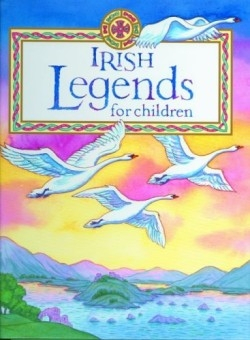Irish Legends for Children
In Ireland, every stone in the road has a name and a story, and telling these stories is an essential skill for conveying the nation’s history and culture. Countless Irish legends have been passed on orally down the generations. This tradition is dying, due to the proliferation of television and film. The author counters that trend in this lovely volume by retelling six classic Irish tales.
In one story, Fionn must prove himself to the High King of Tara. In another, an evil stepmother says to her stepchildren: “I have put a spell on you…You will be swans for nine hundred years.” In a third, Oisín is transported to a magical land where time stops. Some stories stand alone; others are connected, recounting together the legendary history of this mystifying island.
Carroll has written several other collections of Celtic sagas for children, and a biography of the heroic bandmaster of the ill-fated Titanic, whose last port of call was an Irish harbor. The tales here are rich with Irish culture, describing details like hurling (a traditional sport played with balls and hockey-like sticks) and the training once given to warriors and poets. Carroll tells them with simplicity and elegance.
Like Greek legends, many Irish stories warn mortals that they cannot escape their fate. “Deirdre of the Sorrows” is a romance that emphasizes the tension and anger between Ulster and Connacht, two of Ireland’s four provinces. Despite human attempts to avert the agony, “Deirdre did bring sorrow to Ulster just as the druids had foretold.”
The illustrations, in lush watercolor washes and clear pen-and-ink outlines, render a balance of clarity and mystery, so that the magical people seem human and the fantastical situations seem realistic. The illustrator has created art for dozens of children’s books, including the “Kitten and Baby Kitten” series for toddlers, drawings for “Hooked on Phonics” chapter books, and Abracadabra, a children’s graphic novel.
A pronunciation guide would have been helpful, especially to support the book’s possible role in reviving the Irish storytelling tradition; most readers won’t know to pronounce Aoife as “eefa,” or “Oisín” as “o-sheen,” or how to wrap their tongues around “Tír na nÿg.”
These stories depict magic, violence, and beauty, as well as values like loyalty, honesty, strength, duty, and the knowledge of poetry and song. In one tale, the boy Setanta takes the place of the king’s hound that he killed, thus earning the name Cú Chulainn, which means “the hound of Culann, the king of Dundalk.” In later legends Cú Chulainn performs great feats that affect the history of Ireland, a history well served by this beautiful book of classic legends.
Reviewed by
Karen McCarthy
Disclosure: This article is not an endorsement, but a review. The publisher of this book provided free copies of the book to have their book reviewed by a professional reviewer. No fee was paid by the publisher for this review. Foreword Reviews only recommends books that we love. Foreword Magazine, Inc. is disclosing this in accordance with the Federal Trade Commission’s 16 CFR, Part 255.

